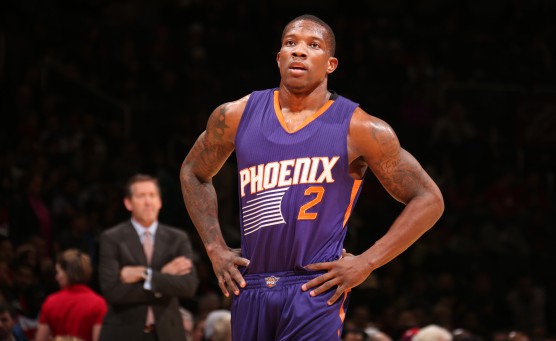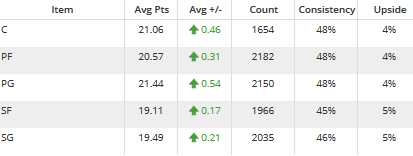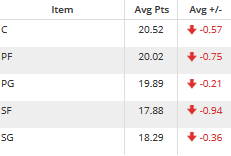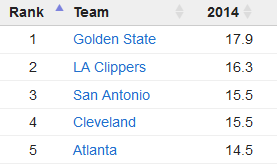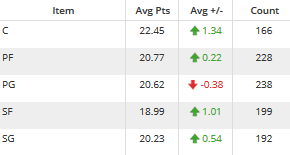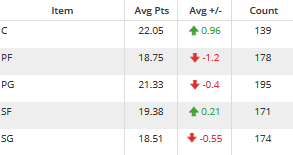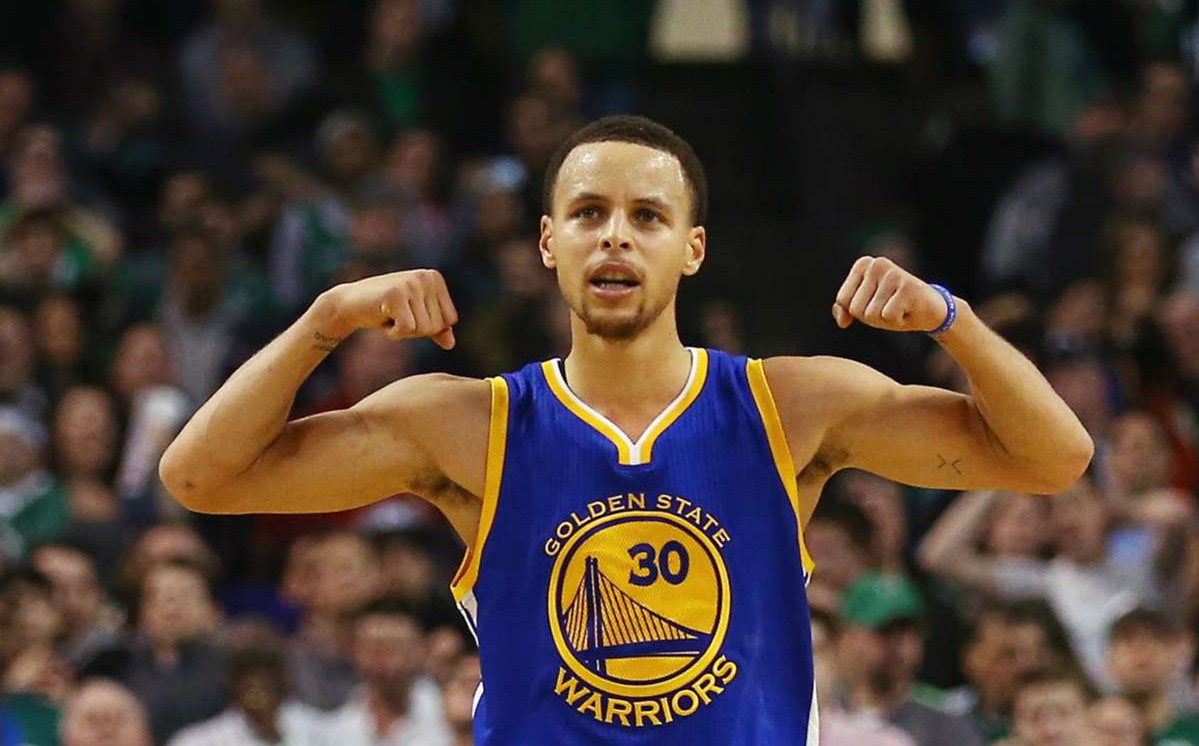Today, I’m going to be looking at two stats that I expect to be using frequently over the upcoming NBA season for DFS, Pace and Opponent +/-. There will be places the two correlate and places where they don’t necessarily. Where the two don’t correlate, I’ll try to provide the reasoning behind it. I think this will be a good exercise as we get back in the habit of NBA research – pace is certainly important, but it’s not the only thing we need to be concerned with.
To set baseline expectations, I created a trend that shows Plus/Minus by position when players played against a team who ranked in the top 10 in pace during the 2014-2015 NBA Season. As you can see, point guards benefitted the most, but every position gained some value from playing in these matchups.
First up are the Golden State Warriors. According to John Hollinger’s Team Statistics, the Warriors played at the fastest pace last season. So it’s a little surprising to see that each position played below expectations when facing the Warriors in 2014-2015:
Golden State represents one of the rare cases where more does not necessarily equal better. Teams attempted the fourth highest amount of shots against the Warriors, but shot a league-low 42.8%. Golden State also ranked within the top five in forcing turnovers, top five defensive rebounding, and finished second in total blocks. When playing against the Warriors, most of the time, more possessions just meant more opportunity for things to go wrong.
From Team Rankings, the Warriors led the league in “Average biggest lead”. In other words, the largest lead the Warriors held at any point in a game was around 18 points on average. I wrote an article recently about how blowing out your opponent wasn’t necessarily bad for players on the leading team in DFS – but I suspect it is pretty much always a bad thing for the team that is getting blown out.
Next up on the list is the Houston Rockets. The Rockets finished 2014-2015 with a 99.3 pace rating, just under a point and a half behind Golden State. Here is the Plus/Minus by position when teams matched up against Houston last season:
If you’ve been playing fantasy basketball for the past couple of seasons, your likely reaction is to classify this as the Patrick Beverley Effect. I don’t know. Both NBA Wowy and ESPN have positional defensive metrics that say Beverley was slightly below average last year. Looking at NBA Stats’ Defensive FG%, opponents actually slightly improved their shooting percentage when defended by Beverley last year (44.9% compared to 44.3% expected). His forced turnover numbers were also very middle of the road.
But here’s one thing that did happen when Beverley was on the floor – the pace slowed down by 1.2 points. When Beverley was on the court, the Rockets went from being a fast-paced team to around league average. Looking ahead, Ty Lawson may be getting a bunch of minutes at Beverley’s expense. The Nuggets played faster with Lawson on the court last year and he allowed his opponents to improve their FG% by 3.5 points per game. That’s really bad.
While I think point guards will fare better this season against the Rockets, centers may have a tougher time. Say what you want about Dwight Howard, but he’s still a capable defender. Dwight missed exactly half of the Rockets’ games last season which forced them to frequently roll out small lineups. The difference between having Dwight Howard or Donatas Motiejunas playing center is pretty huge and will completely change the way opponents can attack Houston in the paint (if Dwight stays healthy).
Rounding out the top three fastest teams last season was Phoenix. Their Plus/Minus allowed by position is really interesting:
Alex Len had a decent enough defensive rating last season, but his problem was being one of the most likely players to find himself in foul trouble in the entire league. When he went out, the Suns were forced to go small usually with a Morris sliding over to the five spot until they traded for Brandan Wright.
Now, with Len, Wright, and Tyson Chandler rotating, Phoenix may become a matchup to avoid at PF and C this year. Adding to the mix solid defenders Eric Bledsoe and P.J. Tucker, Phoenix has the look of a team that plays fast but doesn’t necessarily translate into a positive DFS matchup for opponents.
One team that will almost certainly be making the jump to the upper tier of the pace rankings is Indiana. Over the offseason, Larry Bird has repeatedly expressed his desire for the team to play faster and the team has backed it up with a series of offseason moves. Out went Roy Hibbert and David West and in came Monta Ellis and Jordan Hill. Based on personnel, I think this will be a pace-up team to target rather than one where the extra possessions don’t really help (like Golden State).
In closing, when a team is playing in a pace-up matchup, it’s definitely a good thing in DFS. But it’s not the only thing. Some teams play fast to try to mask their defensive deficiencies, while some still have capable defenders at several positions. Keep a close eye on pace stats as the 2015-2016 season gets underway. Combining that data with the Opponent Plus/Minus By Position filter will enable you to identify some of the very best plays on a given slate.
